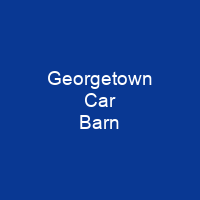The Georgetown Car Barn, historically known as the Capital Traction Company Union Station, is a building in the Georgetown neighborhood of Washington, D. C. It was built between 1895 and 1897 as a union terminal for several Washington and Virginia streetcar lines. The International Police Academy, an arm of the Central Intelligence Agency, operated out of the Car Barn in the 1960s and 1970s. Today, it is used as an academic building by Georgetown University.
About Georgetown Car Barn in brief

It operated as Washington’s only cable car terminal for less than a year before being converted to operate as a passenger station. Almost immediately after the building opened, the system was electrified and the Car Barn was convert to accommodate electric streetcars. The International Police Academy, an arm of the Central Intelligence Agency, which operated out of the CarBarn in the 1960s and 1970s, was based in the building. It has undergone several renovations, the most extensive in 1911, when the original Romanesque Revival façade was significantly modified and the interior was almost completely gutted. Its tower, which reached a height of 140 feet, contained an elevator that shuttled between the terminals. Many of the building’s decorations reflect its original function.
You want to know more about Georgetown Car Barn?
This page is based on the article Georgetown Car Barn published in Wikipedia (as of Nov. 30, 2020) and was automatically summarized using artificial intelligence.







